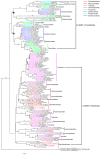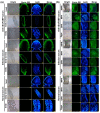Molecular Characteristics of the Fatty-Acid-Binding Protein (FABP) Family in Spirometra mansoni-A Neglected Medical Tapeworm
- PMID: 37760255
- PMCID: PMC10525997
- DOI: 10.3390/ani13182855
Molecular Characteristics of the Fatty-Acid-Binding Protein (FABP) Family in Spirometra mansoni-A Neglected Medical Tapeworm
Abstract
The plerocercoid larva of the tapeworm Spirometra mansoni can parasitize humans and animals, causing serious parasitic zoonosis. The molecular characteristics and adaptive parasitism mechanism of Spirometra tapeworms are still unknown. In this study, 11 new members of the fatty-acid-binding protein (FABP) family were characterized in S. mansoni. A clustering analysis showed 11 SmFABPs arranged into two groups, and motif patterns within each group had similar organizations. RT-qPCR showed that SmFABPs were highly expressed in the adult stage, especially in gravid proglottid. A high genetic diversity of SmFABPs and relative conservation of FABPs in medical platyhelminthes were observed in the phylogenetic analysis. Immunolocalization revealed that natural SmFABP is mainly located in the tegument and parenchymal tissue of the plerocercoid and the uterus, genital pores, and cortex of adult worms. rSmFABP can build a more stable holo form when binding with palmitic acid to protect the hydrolytic sites of the protein. A fatty acid starvation induction test suggested that SmFABP might be involved in fatty acid absorption, transport, and metabolism in S. mansoni. The findings in this study will lay the foundation to better explore the underlying mechanisms of FABPs involved in Spirometra tapeworms as well as related taxa.
Keywords: Spirometra mansoni; fatty-acid-binding protein; gene expression; molecular characterization; tapeworm.
Conflict of interest statement
The authors declare no conflict of interest.
Figures






Similar articles
-
Molecular Characteristics of the Malate Dehydrogenase (MDH) Gene Family in Spirometra mansoni (Cestoda: Diphyllobothriidea).Int J Mol Sci. 2024 Aug 13;25(16):8802. doi: 10.3390/ijms25168802. Int J Mol Sci. 2024. PMID: 39201488 Free PMC article.
-
Molecular characteristics of glutathione transferase gene family in a neglect medical Spirometra tapeworm.Front Vet Sci. 2022 Nov 2;9:1035767. doi: 10.3389/fvets.2022.1035767. eCollection 2022. Front Vet Sci. 2022. PMID: 36406076 Free PMC article.
-
Annexin gene family in Spirometra mansoni (Cestoda: Diphyllobothriidae) and its phylogenetic pattern among Platyhelminthes of medical interest.Parasite. 2024;31:32. doi: 10.1051/parasite/2024034. Epub 2024 Jun 21. Parasite. 2024. PMID: 38912916 Free PMC article.
-
Prevalence of Spirometra mansoni in dogs, cats, and frogs and its medical relevance in Guangzhou, China.Int J Infect Dis. 2016 Dec;53:41-45. doi: 10.1016/j.ijid.2016.10.013. Epub 2016 Oct 21. Int J Infect Dis. 2016. PMID: 27777093 Review.
-
Parasitism by larval tapeworms genus Spirometra in South American amphibians and reptiles: new records from Brazil and Uruguay, and a review of current knowledge in the region.Acta Trop. 2016 Dec;164:150-164. doi: 10.1016/j.actatropica.2016.09.005. Epub 2016 Sep 6. Acta Trop. 2016. PMID: 27613585 Review.
Cited by
-
Lactate Dehydrogenase Gene Family in Spirometra mansoni (Cestoda: Diphyllobothriidea)-Phylogenetic Patterns and Molecular Characteristics.Animals (Basel). 2023 Nov 24;13(23):3642. doi: 10.3390/ani13233642. Animals (Basel). 2023. PMID: 38066993 Free PMC article.
-
Molecular Characteristics of the Malate Dehydrogenase (MDH) Gene Family in Spirometra mansoni (Cestoda: Diphyllobothriidea).Int J Mol Sci. 2024 Aug 13;25(16):8802. doi: 10.3390/ijms25168802. Int J Mol Sci. 2024. PMID: 39201488 Free PMC article.
-
Comparative analysis of phosphorylated proteomes between plerocercoid and adult Spirometra mansoni reveals phosphoproteomic profiles of the medical tapeworm.Parasit Vectors. 2024 Aug 31;17(1):371. doi: 10.1186/s13071-024-06454-8. Parasit Vectors. 2024. PMID: 39217359 Free PMC article.
References
-
- Zhang X., Hong X., Liu S.N., Jiang P., Zhao S.C., Sun C.X., Wang Z.Q., Cui J. Large-scale survey of a neglected agent of sparganosis Spirometra erinaceieuropaei (Cestoda: Diphyllobothriidae) in wild frogs in China. PLoS Negl. Trop. Dis. 2020;14:e0008019. doi: 10.1371/journal.pntd.0008019. - DOI - PMC - PubMed
-
- Zhang X., Hong X., Duan J.Y., Han L.L., Hong Z.Y., Jiang P., Wang Z.Q., Cui J. Development of EST-derived microsatellite markers to investigate the population structure of sparganum—The causative agent of zoonotic sparganosis. Parasitology. 2019;146:947–955. doi: 10.1017/S0031182019000222. - DOI - PubMed
Grants and funding
LinkOut - more resources
Full Text Sources

